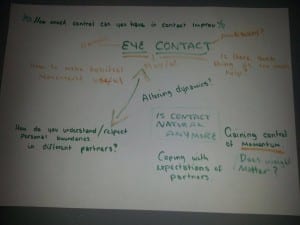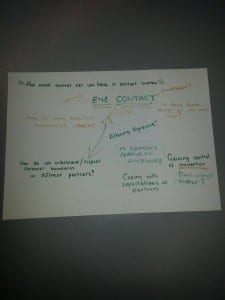I went into this week’s contact lesson with a very positive mind, I was confident with the research lab that we had created and I was interested to see what we would find. I was interested to see what everyone else had come up with and I was also excited to see what a contact improv lesson might feel like when it hadn’t been lead by Kirsty. This week our readings were online articles by Daniel Lepkoff, one about Release Technique and one about Contact Improvisation. These readings I found were the most interesting readings we have yet had. ‘The underlying technique needed to prepare for and survive the surprises of a Contact Improvisation duet is to pose and maintain a question.’ (Lepkoff, 2008). This statement from Contact Improvisation”: A question made me understand for the first time that contact is actually a question as a whole. There is no real right or wrong in contact improv, something that before now I have never really understood. For example I am always doubting myself in this practice, comparing myself to others and not understanding why what I do doesn’t look like everyone else.
The article posts questions that you could ask yourself when improvising such as, ‘what surfaces of my skin are being touched or touching?’ (Lepkoff, 2008). This is a question that I would never think about, but perhaps by putting this into practice, I may be able to improve what I am performing. The article has given me confidence and made me believe that not everyone can feel as confident as they look while dancing. What is Release Technique? also got me thinking differently about contact. ‘one needed to address the functioning of the whole organism, the mind as well as the body’ (Lepkoff, 1999). This is something that I have never really thought about before, I am always so concentrated on what my body is portraying. What am I actually thinking about as I improvise? I want to find the answer to this in the upcoming weeks. I also want to see if whatever I am thinking about while i’m improvising turns out to be something that is in fact holding my movement process back.
Research Lab- Eye contact in Contact Improvisation.
Our research lab was based on this, whether eye contact in fact improved or made contact improv awkward. We created 3 main exercises based on eye contact, but varying within eyes closed or eye contact from far away or up close.
The first exercise we chose was for everyone to get a partner, close their eyes and sit back to back and begin to improvise. The main point of this exercise was to see how fast people would relax into a new partner once we asked them to move, obviously keeping their eyes closed though!! As we asked the group to change partners, the awkwardness became apparent pretty much straight away. A room that was previously silent turned to laughter and timid gestures. The awkwardness between dancers returned and the improvisation seemed strange and timid. Although all the dancers found their new partner in under a minute, the connections between the new partner and their previous one was nowhere near as strong. By stripping away their eye contact it was hard for the bodies to find another clear way of connection, something that before I know I have been heavily reliant on. When we asked the group what they thought of this exercise they agreed with our observations, eye contact, or lack of, had become something in which was a hindrance to the way they were improvising.
We then moved onto the second exercise in which two dancers had to be together, improvise and then we would shout STOP and the dancers would have to force eye contact together no matter what position they were in. As we began this I saw what were some very interesting movements, as the girls looked for contact with their partner it was interesting to see the positions that the bodies went in. Some dancers had to lean back making the next movement in their improvisation different and definitely varied from the movement they had previously done. We then told them to try and head in the direction their eyes were looking at the end of the improv, this meant that most dancers were looking away from each other. This is something I found interesting, why are we more comfortable looking away from our partner than towards them? As soon as the dancers were allowed to look away again, they would release back into the notion that everything was ok. When asked about this exercise the group had a mixed response, some agreed that the eye contact was awkward, whereas others said that it helped them establish a better connection and they felt they could trust their partner more.
We then did an exercise based on eye contact across the room, in which you could just catch someone’s eye contact and then see where the improvisation could go from there. The connections made here were definitely the weakest from all the 3 exercises, dancers were panicking and trying to make connections out of nothing. I feel this is because they didn’t want to be the ones left without a partner as that would make them feel exposed. As the girls began to improvise I could see that these connections were fake, and were simply being done as that is what they thought they ‘had to’.
I feel eye contact in improvisation is still something that will be neglected in weeks to come, due to it making the movement awkward. As a society we run away from eye contact and I feel this is the same in dance, when forced it makes us tense and awkward. Something that in improvisation especially contact could never help the movement. I will try and work on eye contact in future weeks, but I don’t believe it will ever be something that will ever come naturally to me.
Lepkoff, D. (1999) What is Release Technique? Daniel Lepkoff. Available from http://www.daniellepkoff.com/Writings/What%20is%20Release.php. [Accessed 27/10/2015].
Lepkoff, D. (2008) Contact Improvisation: A Question? Daniel Lepkoff. Available from http://www.daniellepkoff.com/Writings/CI%20A%20question.php. [Accessed 27/10/2015]

